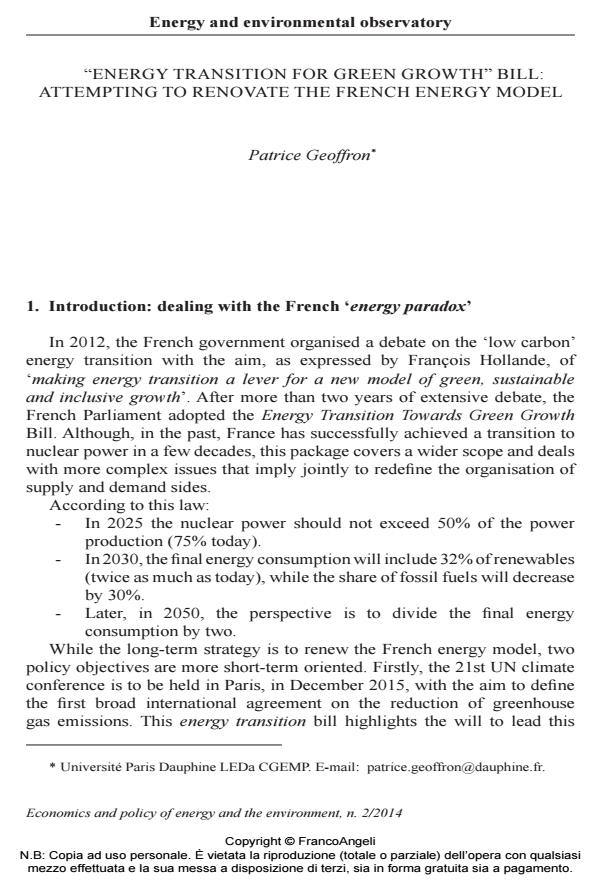"Energy transition for green growth" bill: attempting to renovate the French Energy model
Journal title ECONOMICS AND POLICY OF ENERGY AND THE ENVIRONMENT
Author/s Patrice Geoffron
Publishing Year 2015 Issue 2014/2 Language English
Pages 16 P. 5-20 File size 270 KB
DOI 10.3280/EFE2014-002001
DOI is like a bar code for intellectual property: to have more infomation
click here
Below, you can see the article first page
If you want to buy this article in PDF format, you can do it, following the instructions to buy download credits

FrancoAngeli is member of Publishers International Linking Association, Inc (PILA), a not-for-profit association which run the CrossRef service enabling links to and from online scholarly content.
In 2015, the French Parliament passed a law that defines a strategy for energy transition after two years of open public debate. This legislative package outlines ambitious policy measures to reduce energy consumption and comprises an unprecedented effort to renovate homes and buildings. On the supply side, the Law aims for a diversification of energy sources with a phasing down of nuclear and the speeding up of renewable energy sources. Furthermore, by promoting a ‘circular’ economic model and positive-energy territories, it redefines the balance of power in favour of regional authorities, potentially leading to a turning point in French energy policy. But the Law also includes contradictions and grey areas. It is wishful thinking to believe in the phasing down of nuclear from 75% to 50% of the power production in 2025, combined with the stepping up of renewables to 40% of electricity consumption in 2030. And the current economic crisis puts a cap on the capacity of the State, as well as on local and regional authorities, to trigger the transition and, due to the same constraints, it is doubtful that households and corporations will be able to invest or bear the burden of higher energy prices. Finally, as with the German Energiewende, the French Law illustrates the European difficulties to define collectively a long-term energy strategy.
Keywords: French energy policy, energy transition, green economy
Jel codes: Q42, Q48, Q54
- Nordhaus W. (2011). Designing a friendly space for technological change to slow global warming. Energy Economics.
- OPECST (2011). Rapport sur l’avenir de la filière nucléaire en France, n° 4097. Rotmans J., Kemp R., Van Asselt M. (2001). More evolution than revolution: transition management in public policy. Foresight, 3, 15-31.
- Smil V. (2010). Energy Transitions: History, Requirements, Prospects. Praeger, Westport, CT.
- Solomon B.D, Krishna K. (2011). The coming sustainable energy transition: History, strategies and outlook. Energy Policy, 39.
- WEC (2014). World Energy Trilemma. World Energy Council.
- WEF (2014). The Global Energy Architecture Performance Index Report. World Economic Forum.
- Loorbach D. (2010). Transition management for sustainable development: a prescriptive, complexity-based governance framework. Governance, 23.
- Geels F.W. (2004). From sectoral systems of innovation to socio-technical systems: insights about dynamics and change from sociology and institutional theory. Res. policy, 33.
- Foxon T.J., Hammond G.P., Pearson P.J. (2010). Developing transition pathways for a low carbon electricity system in the UK. Technological Forecasting and Social Change, 77.
- Edquist C. Systems of innovation. The Oxford handbook of innovation. Oxford University Press, New York. Fouquet R. (2010). The slow research for solutions: Lessons from historical energy transitions by sector and service. Energy Policy, 38.
- CDC Climat (2014). Panorama des financements climatiques en 2011.
- Buchan D. (2014). The French Disconnection: reducing the nuclear share in France’s energy mix. The Oxford Institute for Energy Studies.
- Alkemade F., Hekkert M.P., Negro S.O (2011). Transition policy and innovation policy: Friends or foes? Environmental Innovation and Societal Transitions. 1.
Patrice Geoffron, "Energy transition for green growth" bill: attempting to renovate the French Energy model in "ECONOMICS AND POLICY OF ENERGY AND THE ENVIRONMENT" 2/2014, pp 5-20, DOI: 10.3280/EFE2014-002001